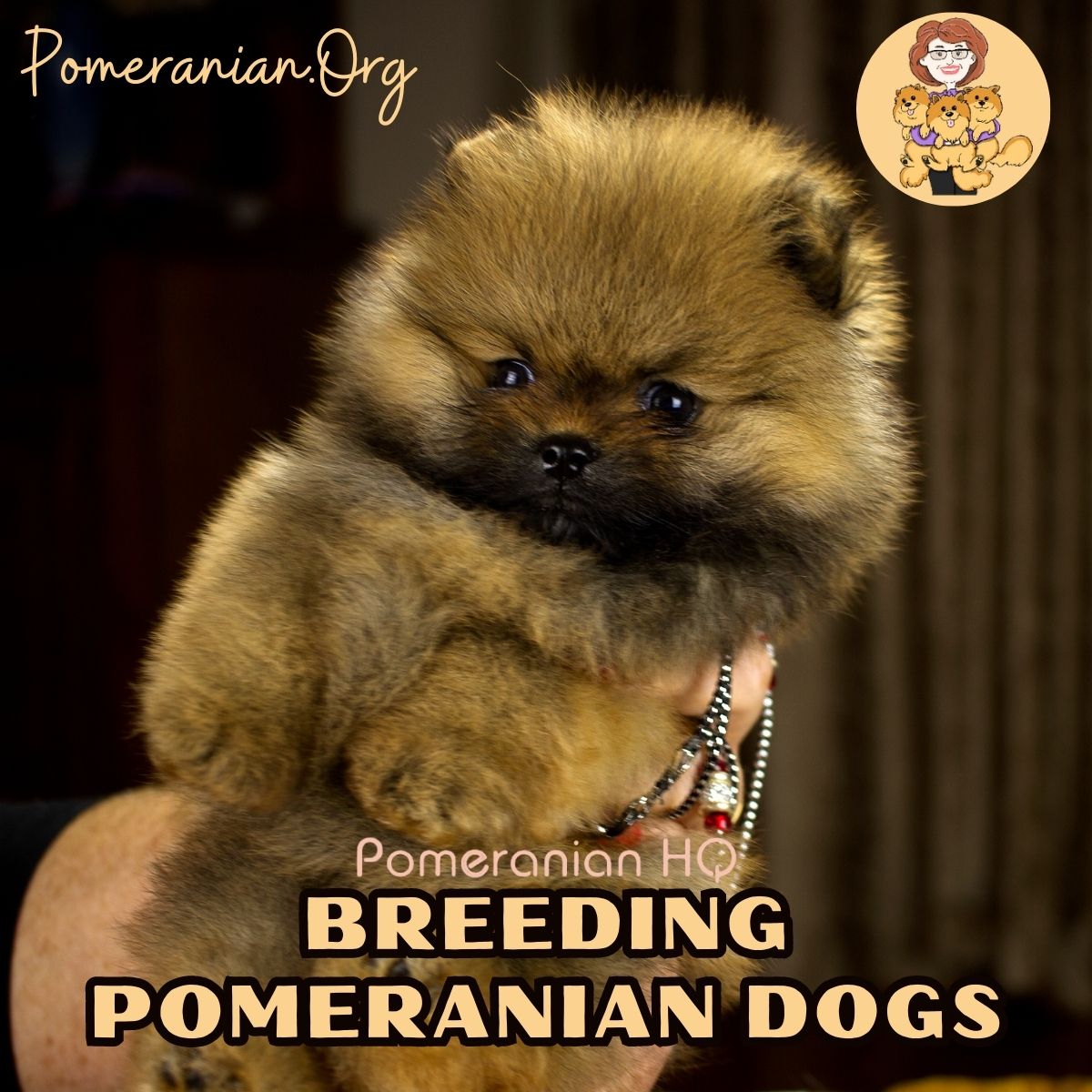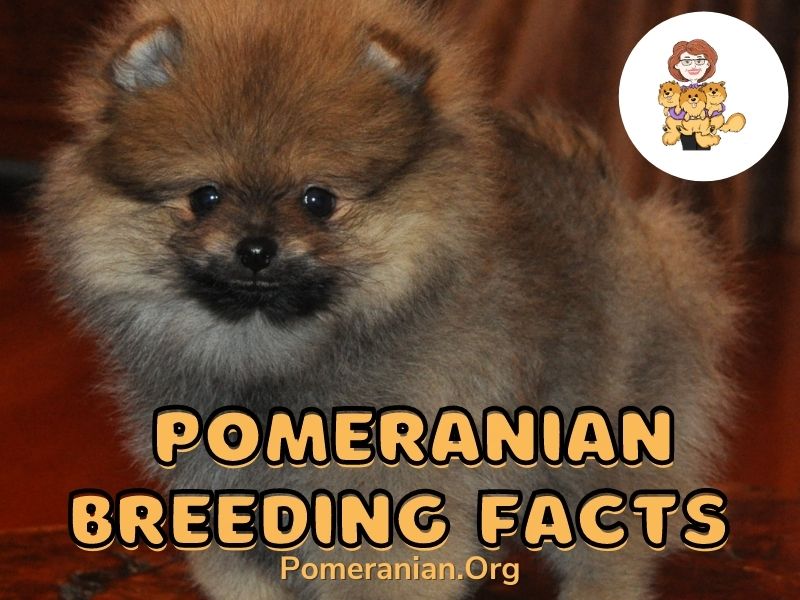Last Updated on 25/04/2024 by Dochlaggie. Post first published on August 7, 2023.
This article will explore all about breeding Pomeranians. Many Pomeranian dog owners consider breeding at least once during their pet’s life. While having a litter of puppies to play with may sound like fun, it’s a lot of hard work.
If you’re not prepared to spend the time and money necessary to do it properly, it’s best not to contemplate breeding Pomeranian dogs in the first place. Breeding Pomeranians for sale can be difficult. Selling puppies is a simple part of the process.

Thoughts on Breeding Pomeranian Dogs by Denise Leo
If you’re new to the Pomeranian breed, here are some insights from my nearly 50-year journey with the breed.
– Familiarize yourself with the Pomeranian breed standard.
– Keep in mind the origins of this breed, as the design should always be in line with its purpose.
– Think of breeding a quality Pomeranian as building something; starting with a strong foundation is key. Study conformation and proper movement.
– An experienced mentor can be invaluable.
– This breed isn’t for the faint of heart.
– Know that owning animals may sometimes involve loss. Don’t become callous, but find a way to honor the lost and move on without being overly hard on yourself.
– Pomeranians, particularly among high-quality females, can be challenging to breed with a higher puppy mortality rate.
– The breed standard emphasizes that females should be larger than males to facilitate reproduction. Be cautious of consistent c-sections.
– Plan ahead when breeding, as you may need to spend time assisting the mother and even bottle-feeding the pups.
– Consider the Pomeranian’s breed standard: “Back short, body compact, well ribbed up, barrel well rounded. Chest fairly deep, not too wide, but in proportion to the dog’s size.” The dog needs space for vital organs.
– My observations over decades show that well-bodied dogs may often have better coats.
– Winning often comes easier with clear orange Pomeranians, but don’t neglect to add other colors like black, heavy sable, and black and tan in your breeding program to maintain coat quality and pigmentation.
– Breeding heavy sables together may lead to “muddy” coats, so diversify your breeding program.
– A high tail set is vital to the breed. Avoid breeding with dogs with lower tail sets.
– Keep in mind the origins of this breed, as the design should always be in line with its purpose.
– This dog has a double coat: the exterior coat is coarse, while the undercoat is soft, thick, and fluffy.
– The paws are shaped like those of a cat, allowing this dog’s ancestors effortless movement across the snow.
– If your Pomeranians are regularly ranked lower, reflect honestly on your own dogs and learn from others rather than complaining about the judging.
– Maintain sportsmanship. Congratulate winners and win or lose with dignity.
– Steer clear of gossip, social media bullying, or breed politics. Criticizing established breeders won’t help you in acquiring quality dogs.
Denise Leo, Dochlaggie Pomeranians.
Realities of Breeding Pomeranian Dogs:
- Finding a caring home for each one.
- Responsibility for tracking the sold puppies for the rest of their lives.
- Having to keep unwanted puppies yourself or ones that the owner has grown tired of or can’t manage the appropriate level of care. Studies reveal that 10% of puppies end up remaining with their owner.
Having enough time, money, and space to provide excellent care for dogs in your home. You have a duty of care to your puppies and their purchasers to produce the healthiest dogs possible. Every breed has temperament and genetic problems that may be passed to the puppies.
You need years of knowledge and experience to recognize any problems. Even if a dog has no visible problem, he may pass it on to the puppies genetically. Extensive, expensive testing and comprehensive knowledge of pedigrees and breeding are needed to avoid puppies with major health issues.
Pomeranian Health Testing
Before considering breeding, reputable breeders thoroughly check their dogs for eye diseases, allergies, coat problems, hormone and thyroid issues, patella luxation, elbow and hip dysplasia, bleeding problems, and many other issues.
Pomeranian Health Guarantee
A breeder must guarantee the puppies’ health (genetically speaking) until they become adults. This may include refunding or replacing a dog many years later.
Lots of places have “lemon laws,” which mean a breeder is obliged to pay for medical bills or refund up to triple the amount paid for the dog in the first place. Even the temperament of a dog is covered by a guarantee because nobody wants a dog who bites, as that may result in a lawsuit.
You’ll need to be available to offer advice to buyers regarding medical issues, behavioral problems, and training, and this support service is likely to continue for 10-15 years.
If you’re making your dog available as a Pomeranian stud service, you still have a responsibility to care for all puppies bred as a result, as do the owners of the female Pomeranian bred to your Pomeranian stud dog.
Pomeranian Breeder Responsibility

Being a Pomeranian breeder means you’re responsible for the reproductive future of all puppies you sell. It’s very expensive to care for dogs and litter. You need to spend a bucket of money on your bitch before she’s old enough to produce puppies.
This can include Pomeranian stud fee, pre-whelping and post-whelping exams, x-rays and shots, removing the dewclaw, tail docking, two sets of puppy injections, worming medication, and equipment such as crates, playpens, whelping boxes, and heating pads.
Difficult pregnancies are very common. Then there’s the cost of food, bedding, toys, and the certification needed so she can breed.
You also need a good quality Pomeranian stud dog, and he’s quite expensive as well.
If you have a job besides being a breeder, you’ll need time off work to help with the whelping and monitor the mother and pups for the first few days to ensure there aren’t any problems.
Dogs may not know what to do and could accidentally kill one or more puppies if you’re not there at an important time.
There’s a 25% mortality rate in newborn Pomeranian puppies, regardless of how well they’re looked after. You bitch may lose her own life if there are whelping problems when you’re not available to care for her.
Selling Pomeranian Puppies
When you’re ready to sell your puppies, advertising expenses will increase. It can take up to four months to locate a good home for the whole litter. Even the breeders of the highest quality show dogs hardly ever cover all their costs.
It may seem like having one litter won’t affect the number of dogs in the total population, but if your bitch or dog merely produces four puppies and each of them only produces a single litter and so on, after seven years, your dog will have over 4000 descendants. This clearly shows the serious repercussions of having one single litter.
Pomeranian Whelping Complications
Smaller dogs, such as the Pomeranian, may suffer from whelping complications, which can easily rack up hefty vet fees. If the mother can’t whelp naturally, a C-section is needed, and this is also common for Pomeranians. One C-section can cost up to $5000.
There are a multitude of problems that may occur, so your dam needs plenty of postpartum care. Typical reproduction problems that can follow whelping include agalactia, eclampsia, metritis, and mastitis.
Knowledgeable breeders have a nickname for Pomeranians – “the heartbreak breed.” If sufficient advice and help aren’t offered fast enough, the mother and/or puppies may die.
The mother might be incapable of feeding the puppies. If so, they need to be bottle-fed or tube-fed every two hours around the clock for a number of weeks. The puppy should stay as clean as possible, and you may need to give the puppy help with bowel and bladder emptying after every feed.

Do you feel certain that you have the time, energy, and motivation to provide the right care for Pomeranian puppies successfully? It takes an immense amount of effort and boundless energy to look after this breed of puppies and the other dogs you own, including their mother. If you believe the Pomeranian breeders rake in the money, forget it.
Ask experienced, registered breeders if they make plenty of cash, and I’m certain their replies will be a resounding “NO!” Unless your Pomeranian is an exceptional breed type, is registered with a Kennel Club, and you’re prepared to find the most compatible match with which to mate her, stop!
Think long and hard before making such a huge decision. Sadly, most dog shelters are vastly overcrowded, and most dogs housed there are unwanted, untrained, and may have been there for a long time.
Ask Yourself These Questions Before Breeding Your Pomeranian
- Do you have access to a very experienced vet 24/7?
- Do you have enough money to pay all the important vet bills related to caring for a mother and her puppies? This includes unexpected emergencies.
- Can somebody in the homestay home look after the litter’s daily needs?
- Can I find a secure, safe, permanent, loving home where the puppies can thrive?
- Well-known breeders usually have plenty of contacts and homes ready to accept responsibility for a puppy litter.
- If the worst-case scenario happens and the new owner can’t care for the dogs any longer, can the breeder return them to his loving home indefinitely?
- Does the buyer know if the puppy has any gene defects? Buyers can return dogs if they have defects, and the breeder must fully refund their money.
- Your female Pomeranian won’t necessarily have a litter before the owner desexes her. Doing this greatly decreases the risk of mammary and other tumors growing later in life. All pet Pomeranians should be desexed around puberty.
Consider The Reasons Before Breeding Pomeranian Dogs
These are a few of the popular reasons for breeding a pet Pomeranian:
The Kids Want the Puppies
Giving birth isn’t a pretty sight. It commonly happens in the middle of the night, and the kids may be scared at the sounds the bitch makes when in labor. You can get DVDs and books showing children what it’s like to give birth without spending a fortune in money and time and caring for a real litter.
I Want Another Pomeranian Identical to My Pomeranian
No two dogs are the same. Each one has it; own unique behavior and personality. The puppies have a 50% chance of taking after the other parent. Most of the dog’s personality will be developed as he grows, not inherited.
We Want Another Pomeranian
Buying a new puppy’s much cheaper and simpler than going through the breeding process.
Our Friends Want a Pomeranian
Yes, they may want a puppy when they say it. However, when the time comes, it’s not a good time for many reasons, and you’re left with puppies you never wanted in the first place.
We Want to Get Back the Money We Invested in Our Dog.
It’s rare ever to make a profit when breeding puppies. Raising a litter will cost you much more than you could have imagined. You probably bought a dog initially for companionship and fun, and even if you spent $500, that equates to $50 per year if he only lives for ten years. It’s less than $1 weekly and much cheaper than a cup of coffee.
My Pomeranian Needs This Experience
This is a fallacy on both counts. Hormones govern sex in animals. There’s no thought process or emotion attached to it. A bitch only “thinks” about having sex when she’s in that season.
Once it has finished, she forgets all about it. Males only think about it when they’re in the presence of a bitch in heat.
Breeding never settles a dog. It makes males worse. He gets more aggressive and territorial, can lose his usual house manners, and will be almost impossible to control if there’s a bitch in heat nearby. If they’re virgins, they don’t miss it. Settling a dog isn’t sex; it’s training and maturity.
Nature Intended Dogs to Produce Puppies
People control the pet’s reproductive lifestyle. Nature’s way is different from ours. Nature didn’t want animals ever to reproduce.
In the wild, only the strongest, smartest, and fittest last long enough to reproduce. Females can only get pregnant when the environment and food supply are such that the babies have a good future.
People let animals procreate whenever they want to, regardless of the consequences. Bitches need not have a litter before they’re spayed. Anyone claiming this to be the case is living in a dream world.
Studies show that puppies can be neutered or spayed and not suffer. Spaying a bitch before her first heat period decreases the risk of uterine infections and breast cancer.
Neutering a male doesn’t make him into a wimp. It makes him easier to train by channeling sexual energy into other areas of his life.
Pomeranian Breeding Requirements
If you have decided to show and breeding Pomeranians is for you, we welcome you. You must join the Kennel Club and learn the record-keeping requirements and their rules.
They can conduct surprise inspections. If your records don’t meet their satisfaction, they may not register your litter and fine and suspend you from registration for life.
The first step in breeding quality Pomeranians is to contact the Kennel Club to get referrals to national and local breeding clubs. Join a club, and you’ll be able to learn from other breeders.
Take out subscriptions to various dog magazines, including the Kennel Club magazine. Improve your knowledge by reading everything you can about breeding your dog and all dogs.
You’ll need to learn anatomy, structure, medical issues, training, psychology, behavior, and more. Attend dog shows to learn how to make your dog better than the average breed. You need to learn what the “breed standard” actually means.
Every Kennel Club-recognized breed will have a written description of perfection. This covers his look, how he moves, and how he acts. A serious breeder compares his dog to the standard, which helps him decide whether to breed.
It takes a long time and plenty of exposure to truly understand the standards and the characteristics that make a dog special. You’ll learn if your dog has such characteristics and if breeding would improve the quality of the breed overall. That’s the only goal and reason to breed any dog – to produce an animal that has an exceptional appearance, temperament, health, and trainability.
This may take years, and you might discover that, although your dog is a great pet, he may not be the ideal breeding stock. Many Pomeranian puppy breeders have faced this same realization.
Before considering whether to breed, visit local shelters to see what happens to dogs that started as possible breeding dogs and pets with owners who thought it would be “great fun” to have a litter.
Euthanasia is as educational as the miracle of giving birth. You must fully appreciate the harsh reality and consequences of not successfully breeding. Is it worth it? The decision to breed? Generally, it’s not. The kindest thing you can do for a dog is not to breed him but to care for him as a much-loved pet instead.

How Often, And Until What Age, Can Pomeranians Be Safely Bred?
What a controversial topic! The opinions vary a lot between owners, breeders, and reproduction experts.
Best Age Female Pomeranian for Breeding: How Old Should a Female Dog Be Before Breeding?
Most believe the female dog isn’t mature enough on her first heat cycle. She can’t be bred before her second cycle and needs to be in perfect health before breeding is even tried.
As For Consecutive Pomeranian Pregnancies, There are Three Schools of Thought:
- Breed every second season.
- Breed for two seasons and then skip one season.
- Breed every season with no trouble.
Some experts believe skipping a season isn’t natural and may create a hormonal imbalance that may affect the dam’s health. If a bitch needed C-sections, she would need a longer recovery time between litters.
The American Animal Hospital Association has been quoted as saying: “I know of no stance by any organization, AAHA or AVMA, on people breeding their dogs during each and every heat cycle. I personally don’t recommend it, but there’s no policy by anyone official that I’m aware of at this time.
As far as the effect of consecutive pregnancies is concerned, there’s probably little, if any, effect if the female Pomeranian dog is in good physical condition, to begin with, on each of her pregnancies. You have to remember that this is the way it was designed in nature to keep the population going, and it was survival of the fittest.
Consecutive breedings shouldn’t occur often. One season’s rest (as a minimum) must be allowed between litters. If she has consecutive litters and the first litter only produces a single puppy, she should still have a rest for a year before breeding again.
You may breed her twice if you aim to whelp her at a better time of year. This may be desired if she had a small litter or had infertility issues.
The dam needs to be in perfect health for this to happen, and the litter sizes usually reduce, and the energy and puppy sizes usually decrease as well, so there isn’t a valid reason for it.
One exception can be the female Pomeranian dog, who only has one cycle per year. She can be bred in consecutive seasons because Nature has already determined her cycle to have a year’s rest.
Thoughts on Female Pomeranians for Breeding Age
Some vets and breeders believe female dogs should be spayed at around five years of age, and others believe female dogs can keep being bred until they’re eight years old.
Note that toy dogs age slower than bigger dogs. Then you have the tales of female dogs jumping the fence aged 10 or 11 and finding a Pomeranian stud dog. This female Pomeranian then whelps and produces a healthy litter of four puppies. The reproductive history and health of the female Pomeranian are determining factors the breeder must consider before choosing what to do.
The bottom line is that every breeder needs to weigh up his dog’s health and her previous history and then make an educated decision. When it comes to the age of a female Pomeranian for breeding, again, the opinions vary enormously.

Breeding Pomeranians Conclusion
If you decide to dive into Pomeranian breeding, a lot can go wrong if you don’t know what you are doing. I hope this article has helped answer some questions and ease your mind about what breeders need to know to produce healthy puppies without too much difficulty successfully.
Disclaimer: The Content is not a substitute for professional veterinarian advice, diagnosis, or treatment. Always seek the advice of your veterinarian with any questions you may have regarding your dog’s medical condition. Never disregard professional advice or delay seeking it because of something you have read on ANY website.
Copyright Pomeranian.Org. All rights reserved.
References and Further Reading:
[1] Official Standard of the Pomeranian (AKC). American Kennel Club, 2011.
[2] English Kennel Club Pomeranian Breed Standard, 2017.
[3] Denise Leo, The Pomeranian Handbook.
[4] Milo G. Denlinger “The Complete Pomeranian.”
[5] Kimbering Pomeranians “1891-1991”.
[6] William Taplin’s “The Sportsman’s Cabinet.”
[7] E. Parker “The Popular Pomeranian.”
[8] Lilla Ives “Show Pomeranians.”









